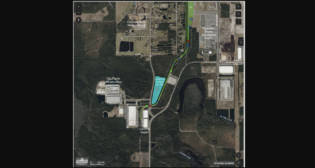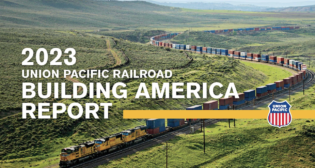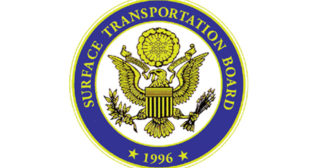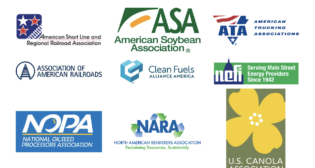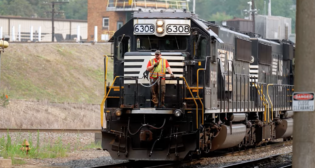
Ensuring Trust, Based on Humanity
Written by Nicholas Little, Director Railway Education, Center for Railway Research and Education, Michigan State University Eli Broad College of Business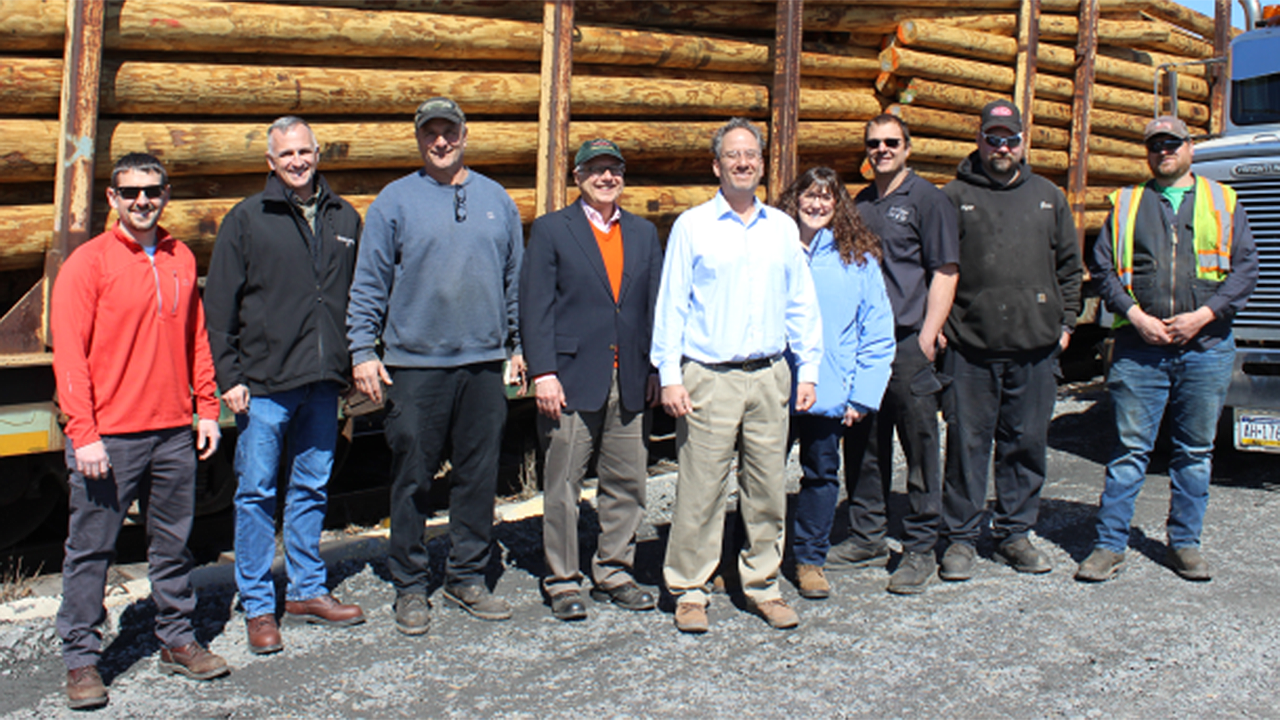
No supply chain runs without people. Left to right, with the first railcar of utility poles for Stella-Jones at the company’s new distribution yard in Morea, Pa.: Eric Peters, Reading & Northern (RBMN) Vice President Transportation; Tyler Glass, RBMN Executive Vice President Transportation; Ettore DiCasimirro, Skytop Fuels Owner; Rian Nemeroff, RBMN Senior Vice President; Brian Kwiatkowski, Stella-Jones Corporation Site Manager; Susan Ludwig, RBMN Vice President; Ettore DiCasimirro, Jr., Skytop Fuels Vice President; Jesse Redgate, Skytop Fuels Head of Operations; and Jim Carr, JFC Hauling, Owner/Operator. RBMN photo
The pandemic and subsequent initiatives emanating from the Biden Administration have catapulted supply chain to the public domain and raised awareness of how critical warehousing and transportation are to the health of the nation’s economy and livelihood of the population. Prior to COVID, supply chain was often a lowly department (frequently referred to as logistics) in a corporate hierarchy.
Supply chain staff worked diligently behind the scenes to keep manufacturing supplied with materials, to support services provided and to deal with occasional crises such as Icelandic volcano dust clouds or industry specific shortages. The automotive industry emerged as a supply chain leader when focusing on Just in Time (JIT) inventory management. Retailing was somewhat different, leading at times particularly with rationalizing products sold but also not great at forecasting seasonal demand fluctuations or trends in fashion. That led to lost revenues as prices were marked down to shift unsold inventory.
During the pandemic, the supply chain was thrown into the public gaze. Rarely did a newscast pass without mentioning some shortage or other, ranging from foods to electronics to scary pictures of very empty supermarket shelves. We rapidly discovered that supply chains were far from linear and were, in fact, a network of different nodes and links. If any one of the links broke or a node underperformed, the ramifications were potentially enormous.
Furthermore, there’s a magnifier effect taking place when disruptions occur. If I know it is harder to find something, then I’m likely to stock up on it when it becomes available (just in case inventory). When extrapolated to market-level demand, this feeds back along a supply chain and eventually results in greater production that is not met by sustained sales volumes and inventory takes up warehouse space. The same happens with railcars and locomotives being put in storage when demand falls.
Transportation is a service that is also a network, whether single or multiple modes, and often includes complexity that is below the surface. Our freight railroad network is one such example. A similar network exists for passenger transportation. Rail transportation, whether for people or freight, is a complex system with many interfaces between organizations and modes of transportation. At every point of contact in such systems, there is a possibility of failure that leads to delay and increased cost.
Let’s set aside the fact that the link can also fail (for instance, a train delayed due to mechanical issues, grade crossing issues, crew time limits and so forth). Instead, let’s concentrate on what happens at each node in the network. In some cases, it is little more than classification of cars from one train to another. Other times, it is interchange from one carrier to another and many times it is first- and last-mile transloading or handover to road haulage or to a customer.
Every supply chain or transportation link is made up of two nodes and the physical link between them. Which is more important, the nodes or the link? They all are important because one cannot function without the others. When all nodes and links perform as expected, all is good and everyone is happy. Unfortunately, the real world isn’t like that. Sometimes our behaviors seem to be designed to create friction in the system. Often this is because our goals, objectives and performance measurement and rewards are different.
We’re all in this together. We depend on other supply chain participants to do their bit effectively and efficiently. The service provided to the end consumer is a sum of all nodes and links in the supply chain. Don’t be misled into thinking supply chains are only about materials and physical things. First, every supply chain has physical components and data components, whether an order, waybill or similar. Knowledge is another important component in the supply chain. Knowledge is not just a sum of all the available data translated into being able to do the job at hand. It is the human side of capability. To know what to do and how to address issues that arise. No supply chain runs without people.

Services also have supply chains. Defining a service is sometimes very difficult. I describe it as tough as nailing Jello to the ceiling! Yet all services have one common factor: people. We know people are essential to keep our railroads running and we value the skills and effort they provide. We also know how difficult it can be to have the right people in the right place at the right time with the right capabilities, skills and competencies. Hiring, retaining and developing the workforce is a vital component in being able to provide a consistent, reliable service.
Thus, there’s a supply chain of knowledge and competency that can be described as capability. Is capability the only thing we look for when evaluating whether we should work with a supply chain partner such as an interchange partner or an intermodal drayage driver or even a 3PL logistics partner?
A recent survey by MHI-Deloitte was published as “Building Trust in Supply Chains” with the following subtitle: “Why Humanity Matters More than Ever.” To summarize, the study sought to determine whether, and how much, overall corporate performance was impacted by business impacts of trust. I’ll share just two of their high-level conclusions.
- The most trustworthy companies outperform their peers by up to 400% in terms of total market value.
- Customers who trust a brand are 88% more likely to buy it again, and employees who trust their employer are more motivated to work and less likely to leave.
Source: 4 Questions to Measure – and Boost – Customer Trust; Reichheld & Dunlop, Nov, 2022
The study also found that best-in-class supply chain organizations are, on average, six times more trusted than their lowest performing counterparts. A significant finding here was that front-line workers rated their leadership’s “humanity” seven times more important than in low-performing organizations.
So, what does “humanity” mean in this context? The researchers defined it as kindness, empathy and fairness. This relationship was also found at the supply chain nodes in terms of both internal trust within the company and externally with suppliers and customers. High-performing suppliers (railways are a supplier to their customers) were three times more likely to prioritize employee development and growth. The research concluded that “treating the people in your organization with humanity is key.”
Taking this back to the supply chain and railroad context, what should we do differently? Clearly, we need to build trust and trusting relationships, and not just within our own companies and organizations. Throughout the supply chain is key. Greater worker trust leads to improved engagement, motivation and loyalty.
So where does customer centricity fit in? Simple: Everyone is a customer—every stakeholder, not just the investors and corporate bankers but every person with whom we interface in moving freight and people efficiently and effectively from points A to B and A to Z. Thus, we need to treat them all, customers, employees, suppliers etc., fairly, with kindness, with respect and with empathy.
I’ve mentioned empathy several times in this story. It’s not a commonly used word in North American railroading. So what does it mean in this context? The Oxford Dictionary defines empathy as “the ability to understand and share the feelings of another person.” I’d expand it to add “or organization.”
Let’s reflect on retail consumer behavior—something we all do daily. In those interactions, we value many different aspects of the relationship. Quality, reliability, capability and availability are just a few dimensions. Think about gasoline for your car as compared with “range anxiety” with electric vehicles. Which is more trusted today? Will it remain like this, or will more chargers, reliable chargers, available chargers build trust in having an EV instead of an internal-combustion-engine vehicle?
My experience with building trust is focused on sustaining reliability. Doing what you said you would do, every time. I started my railway career in England—a passenger railway with the occasional inconvenience of a freight train! Passengers complain, freight doesn’t (though the shipper and receiver can and will do so). Customer centricity was mentioned at an event I attended recently by five of the six Class I railroads. I sure hope that they all realize that there are 500-plus other railroads in North America—Class II, Class III and S&T—who understand this on a day-in and day-out basis.

The small railroads are often the first- and last-mile service providers that work tirelessly to build and maintain excellent customer relationship so that they can provide superb customer experiences for shippers and receivers. However, once they interchange to/from another carrier, they need to know that their customers’ freight will be in the hands of a trusted partner.
We, as an industry, must do all we can to ensure this trust, based on humanity, is realized and recognized. It’s what great supply chain people do all the time, and what every railroad leader must learn to do.
